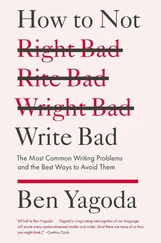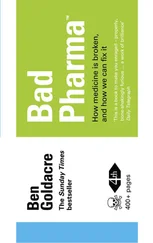Ben Goldacre - Bad Science
Здесь есть возможность читать онлайн «Ben Goldacre - Bad Science» — ознакомительный отрывок электронной книги совершенно бесплатно, а после прочтения отрывка купить полную версию. В некоторых случаях можно слушать аудио, скачать через торрент в формате fb2 и присутствует краткое содержание. Жанр: Публицистика, на английском языке. Описание произведения, (предисловие) а так же отзывы посетителей доступны на портале библиотеки ЛибКат.
- Название:Bad Science
- Автор:
- Жанр:
- Год:неизвестен
- ISBN:нет данных
- Рейтинг книги:5 / 5. Голосов: 1
-
Избранное:Добавить в избранное
- Отзывы:
-
Ваша оценка:
- 100
- 1
- 2
- 3
- 4
- 5
Bad Science: краткое содержание, описание и аннотация
Предлагаем к чтению аннотацию, описание, краткое содержание или предисловие (зависит от того, что написал сам автор книги «Bad Science»). Если вы не нашли необходимую информацию о книге — напишите в комментариях, мы постараемся отыскать её.
Bad Science — читать онлайн ознакомительный отрывок
Ниже представлен текст книги, разбитый по страницам. Система сохранения места последней прочитанной страницы, позволяет с удобством читать онлайн бесплатно книгу «Bad Science», без необходимости каждый раз заново искать на чём Вы остановились. Поставьте закладку, и сможете в любой момент перейти на страницу, на которой закончили чтение.
Интервал:
Закладка:
As well as raising concerns about contamination, D’Souza also found that the O’Leary method might have accidentally amplified the wrong bits of RNA.
Let’s be clear: this is absolutely not about criticising individual researchers. Techniques move on, results are sometimes not replicable, and not all double-checking is practical (although Bustin’s testimony is that standards in the O’Leary lab were problematic). But what is striking is that the media rabidly picked up on the original frightening data, and then completely ignored the new reassuring data. This study by D’Souza, like Afzal before it, was unanimously ignored by the media. It was covered, by my count, in: my column; one Reuters piece which was picked up by nobody; and one post on the lead researcher’s boyfriend’s blog (where he talked about how proud he was of his girlfriend). Nowhere else.
You could say, very reasonably, that this is all very much par for the course: newspapers report the news, and it’s not very interesting if a piece of research comes out saying something is safe. But I would argue – perhaps sanctimoniously – that the media have a special responsibility in this case, because they themselves demanded ‘more research’, and moreover because at the very same time that they were ignoring properly conducted and fully published negative findings, they were talking up scary findings from an unpublished study by Krigsman, a man with a track record of making scary claims which remain unpublished.
MMR is not an isolated case in this regard. You might remember the scare stories about mercury fillings from the past two decades: they come around every few years, usually accompanied by a personal anecdote in which fatigue, dizziness and headaches are all vanquished following the removal of the fillings by one visionary dentist. Traditionally these stories conclude with a suggestion that the dental establishment may well be covering up the truth about mercury, and a demand for more research into its safety.
The first large-scale randomised control trials on the safety of mercury fillings were published recently, and if you were waiting to see these hotly anticipated results, personally demanded by journalists on innumerable newspapers, you’d be out of luck, because they were reported nowhere. Nowhere. A study of more than 1,000 children, where some were given mercury fillings and some mercury-free fillings, measuring kidney function and neurodevelopmental outcomes like memory, coordination, nerve conduction, IQ and so on over several years. It was a well-conducted study. There were no significant differences between the two groups. That’s worth knowing about if you’ve ever been scared by the media’s reports on mercury fillings – and by God, you’d have been scared.
Panorama featured a particularly chilling documentary in 1994 called The Poison in Your Mouth . It opened with dramatic footage of men in full protective gear rolling barrels of mercury around. I’m not giving you the definitive last word on mercury here. But I think we can safely assume there is no Panorama documentary in the pipeline covering the startling new research data suggesting that mercury fillings may not be harmful after all.
In some respects this is just one more illustration of how unreliable intuition can be in assessing risks like those presented with a vaccine: not only is it a flawed strategy for this kind of numerical assessment, on outcomes which are too rare for one person to collect meaningful data on them in their personal journey through life; but the information you are fed by the media about the wider population is ludicrously, outrageously, criminally crooked. So at the end of all this, what has the British news media establishment achieved?
Old diseases return
It’s hardly surprising that the MMR vaccination rate has fallen from 92 per cent in 1996 to 73 per cent today. In some parts of London it’s down to 60 per cent, and figures from 2004–05 showed that in Westminster only 38 per cent per cent of children had both jabs by the age of five.
It is difficult to imagine what could be driving this, if not a brilliantly successful and well-coordinated media anti-MMR campaign, which pitched emotion and hysteria against scientific evidence. Because people listen to journalists: this has been demonstrated repeatedly, and not just with the kinds of stories in this book.
A 2005 study in the Medical Journal of Australia looked at mammogram bookings, and found that during the peak media coverage of Kylie Minogue’s breast cancer, bookings rose by 40 per cent. The increase among previously unscreened women in the forty-to-sixty-nine-year age group was 101 per cent. These surges were unprecedented. And I’m not cherry-picking: a systematic review from the Cochrane Collaboration found five studies looking at the use of specific health interventions before and after media coverage of specific stories, and each found that favourable publicity was associated with greater use, and unfavourable coverage with lower use.
It’s not just the public: medical practice is influenced by the media too, and so are academics. A mischievous paper from the New England Journal of Medicine in 1991 showed that if a study was covered by the New York Times , it was significantly more likely to be cited by other academic papers. Having come this far, you are probably unpicking this study already. Was coverage in the New York Times just a surrogate marker for the importance of the research? History provided the researchers with a control group to compare their results against: for three months, large parts of the paper went on strike, and while the journalists did produce an ‘edition of record’, this newspaper was never actually printed. They wrote stories about academic research, using the same criteria to judge importance that they always had, but the research they wrote about in articles which never saw the light of day saw no increase in citations.
People read newspapers. Despite everything we think we know, their contents seep in, we believe them to be true, and we act upon them, which makes it all the more tragic that their contents are so routinely flawed. Am I extrapolating unfairly from the extreme examples in this book? Perhaps not. In 2008 Gary Schwitzer, an ex-journalist who now works on quantitative studies of the media, published an analysis of five hundred health articles covering treatments from mainstream newspapers in the US. Only 35 per cent of stories were rated satisfactory for whether the journalist had ‘discussed the study methodology and the quality of the evidence’ (because in the media, as we have seen repeatedly in this book, science is about absolute truth statements from arbitrary authority figures in white coats, rather than clear descriptions of studies, and the reasons why people draw conclusions from them). Only 28 per cent adequately covered benefits, and only 33 per cent adequately covered harms. Articles routinely failed to give any useful quantitative information in absolute terms, preferring unhelpful eye-catchers like ‘50 per cent higher’ instead.
In fact there have been systematic quantitative surveys of the accuracy of health coverage in Canada, Australia and America – I’m trying to get one off the ground in the UK – and the results have been universally unimpressive. It seems to me that the state of health coverage in the UK could well be a serious public health issue.
Meanwhile, the incidence of two of the three diseases covered by MMR is now increasing very impressively. We have the highest number of measles cases in England and Wales since current surveillance methods began in 1995, with cases occurring mostly in children who had not been adequately vaccinated: 971 confirmed cases were reported in 2007 (mostly associated with prolonged outbreaks in travelling and religious communities, where vaccine uptake has been historically low), after 740 cases in 2006 (and the first death since 1992). Seventy-three per cent of cases were in the South-East, and most of those were in London.
Читать дальшеИнтервал:
Закладка:
Похожие книги на «Bad Science»
Представляем Вашему вниманию похожие книги на «Bad Science» списком для выбора. Мы отобрали схожую по названию и смыслу литературу в надежде предоставить читателям больше вариантов отыскать новые, интересные, ещё непрочитанные произведения.
Обсуждение, отзывы о книге «Bad Science» и просто собственные мнения читателей. Оставьте ваши комментарии, напишите, что Вы думаете о произведении, его смысле или главных героях. Укажите что конкретно понравилось, а что нет, и почему Вы так считаете.





![Роман Зыков - Роман с Data Science. Как монетизировать большие данные [litres]](/books/438007/roman-zykov-roman-s-data-science-kak-monetizirova-thumb.webp)






